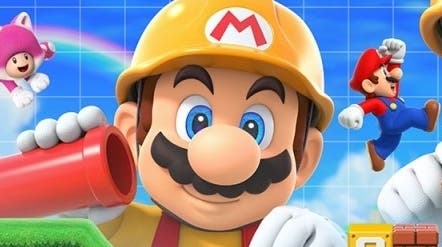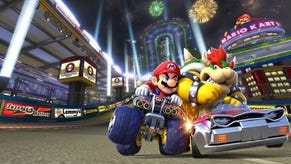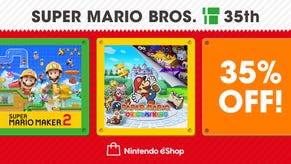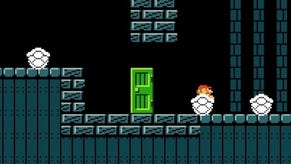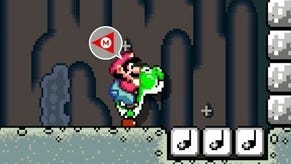Super Mario Maker 2: how Nintendo's switching up its DIY platformer
Mario 3D World style support, story mode and more.
Super Mario Maker 2 is shaping up as an excellent sequel that's a perfect match for Switch's unique hardware. Based on my time playing it at a recent Nintendo press event, the template of its Wii U and 3DS predecessor carries over with a few on-point additions. Not least, there's a tantalising hint of just how a Super Mario 3D World port could manifest on the hybrid console. On top of gifting players an overwhelming wealth of tools for creating their own platforming epics, there's a story mode too, offering a stream of brilliant new levels from Nintendo's own master designers.
The story mode does a surprising amount to tie everything together. I was surprised by how much it gives Mario Maker 2 a focal point once you boot it up - a backbone, if you will - supposing you'd rather let Nintendo shows off the game's tools in the best case. Of course, it's the improved course maker mode - the bit you get to tinker with yourself - that remains the real attraction. On top of its all new items, sounds, bosses and level assets (including sloped surfaces, as a series first) there's now a brand new play style. Mario Maker 2 lets you build levels with visuals based on the Wii U's much-loved Super Mario 3D World, showing what might even be a new engine for the series, with its own unique mechanics and demands.
There are a lot of new features to enjoy over and above this. The expanded online multiplayer lets you jump into an ocean of user-made levels with up to four players, while you can actually build levels in groups of two. But Switch's biggest advance over Wii U is easily in the course maker mode. The 3D World style is in the extra styles section, and while mechanically it's still a 2D side-scroller - unlike the actual game - it comes with a host of visual upgrades over the preceding New Super Mario Bros U style. The fact is that Mario 3D World is one of a handful of Wii U titles to still not get a Switch conversion of some kind, and Mario Maker 2 gives us the ability to see how a port might turn out.
So how does it work? Under the styles section, the original four modes - from Mario Bros 1, 3, World and New Super Mario Bros U - are all accounted for, and freely interchangeable. Visually speaking these translate as-is from the Wii U version. The rules and mechanics differ with each style, but fundamentally they adhere to a similar enough logic that you can switch between them on the fly, after level creation. Supposing you want to change to or from 3D World style, though? Well, that means starting with a blank canvas, building your worlds from scratch. You get translucent pipes, the catsuit and many other mechanics from 3D World that help to spice up the levels. With so much change though, a clean break is needed from the older formats, but it's one that opens up a wealth of new options.
The new style opens up technical differences too. Inevitably, Switch is being pushed hardest in this way given that Super Mario 3D World on Wii U was notable for introducing proper light and shadow interactions, more advanced depth of field, light bloom, and improved specular properties for items like spinning coins. Many of these features are present in the new Mario Maker 2 style, even it's not precisely the same. After all, without an example of true 3D stages, the tilt-shift style of the actual game doesn't come across, though next to the Mario Bros U style it is clearly more daring. The quality of assets and the core engine work running underneath are pushed to another level.
There is trade-off though. At least based on the preview build of Mario Maker 2, the native resolution takes a hit in 3D World mode, with docked play dropping to 1600x900 compared to the native 1920x1080 of the New Super Mario Bros U style (we'll revisit image quality in portable play when we see final code). 900p still counts as an upgrade over the 720p the original game ran at on Wii U, and in this sense, it indicates a possible limitation for a potential Mario 3D World Switch port. Interestingly you do get a pass of edge-detection that helps address aliasing across the game, something we don't get in the other styles.
The older 2D styles are worth touching on. Nintendo has engineered an older sprite-based template for every item and character in-game but resolution-wise it's deliberately built to simulate the limits of NES and Super NES hardware. Or at least, it's a reasonable facsimile of it, with tweaks to better suit today's 1080p displays. When playing either Mario Bros 1, 3 or World, the pixel output here is set to precisely 384x216, which upscales very neatly to 1920x1080 in a linear fashion. Each pixel is a 5x5 block of smaller pixels, giving these clearly defined outlines. Long story short, it means no blurry upscaling. It's a gorgeous way to play and for all the more advanced rendering methods the new 3D World style adds, this is still a genuine highlight
Portable play is worth digging into. It's where Switch separates itself from Wii U and 3DS in some interesting ways. There's a completely different control scheme, depending on how the Switch is being used. Docking the Switch means you're at the mercy of using conventional pad or Joycons to navigate the menu - and in truth, it perhaps isn't as convenient as tapping the screen in portable mode. Wii U had an advantage in that regard, by separating the touchscreen from the main console itself. Still, Mario Maker 2 does at least offer some smart shortcuts on the face buttons, to help speed up navigation but it's difficult to avoid the conclusions that building stages will be a lot easier in the long run using the touch-sensitive screen. And as an added bonus, Nintendo is offering a kind of stylus bundled with pre-orders of the game in Europe and Japan.
Overall, Super Mario Maker 2 looks set to deliver a big improvement over the original on Wii U and 3DS and as expected, everything I've played so far is rock-solid at 60 frames per second. It's worth stressing I was playing a preview build, but all signs here point to a hugely adaptable game built for a system that's adaptable by nature. The concept works in practise as much as it does on paper. The addition of a story mode too, complete with a new play style, justifies its position as a proper Switch sequel rather than a deluxe port.
One thing did strike me as curious; in the extra game styles section, there's a big blank in the menu next to the new 3D World option. This is purely speculation on my part, but could it possibly be reserved for another game style? Even down the road with DLC, it could be fun to, for example, see a Mario Odyssey or Mario Galaxy style lick of paint. There is room to expand Mario Maker 2 further still then, but what's in the package already hits the right notes, and I can't wait to see how far the course maker can be pushed on Switch.
